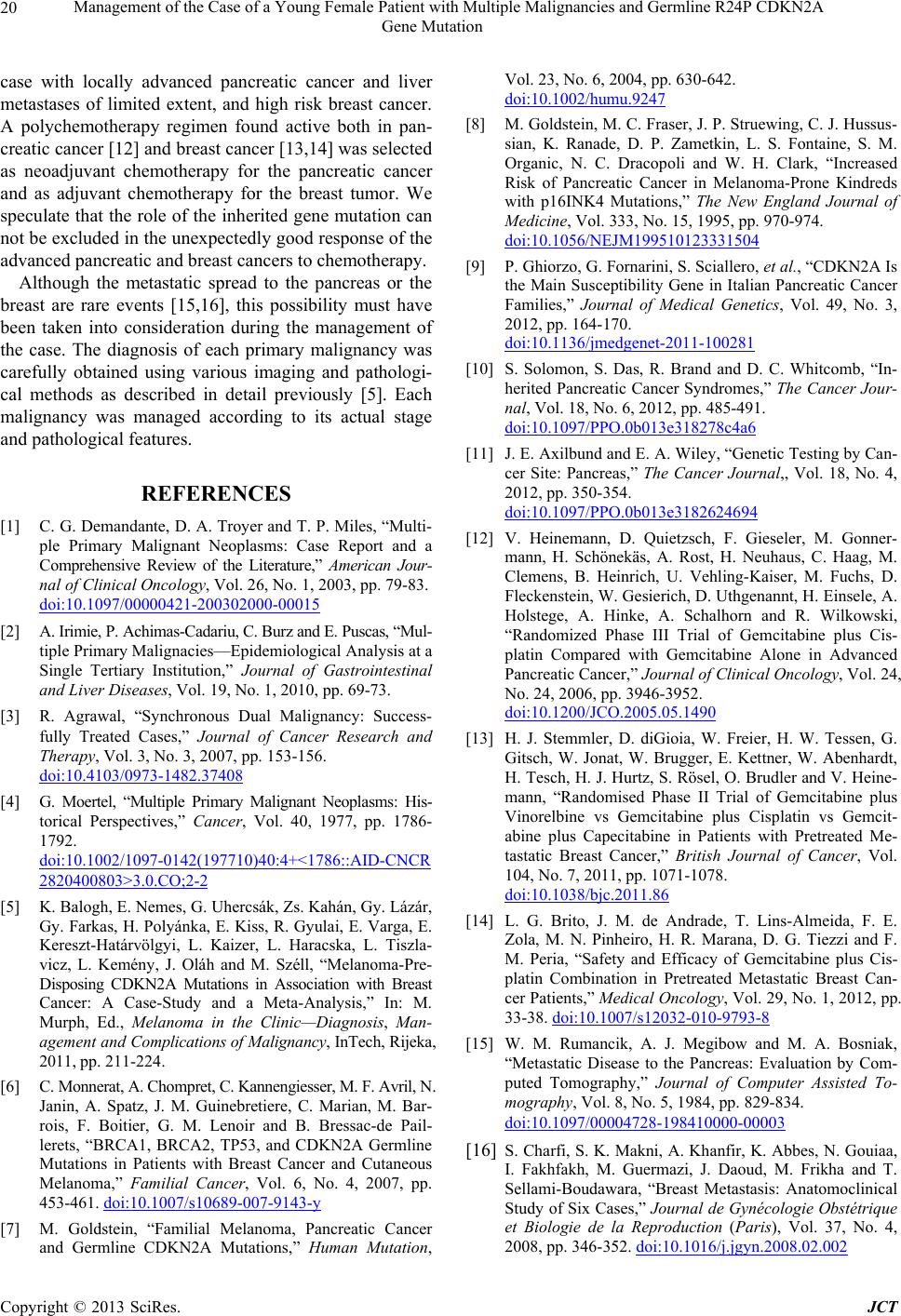
Management of the Case of a Young Female Patient with Multiple Malignancies and Germline R24P CDKN2A
Gene Mutation
20
case with locally advanced pancreatic cancer and liver
metastases of limited extent, and high risk breast cancer.
A polychemotherapy regimen found active both in pan-
creatic cancer [12] and breast cancer [13,14] was selected
as neoadjuvant chemotherapy for the pancreatic cancer
and as adjuvant chemotherapy for the breast tumor. We
speculate that the role of the inherited gene mutation can
not be excluded in the unexpectedly good response of the
advanced pancreatic and breast cancers to chemotherapy.
Although the metastatic spread to the pancreas or the
breast are rare events [15,16], this possibility must have
been taken into consideration during the management of
the case. The diagnosis of each primary malignancy was
carefully obtained using various imaging and pathologi-
cal methods as described in detail previously [5]. Each
malignancy was managed according to its actual stage
and pathological features.
REFERENCES
[1] C. G. Demandante, D. A. Troyer and T. P. Miles, “Multi-
ple Primary Malignant Neoplasms: Case Report and a
Comprehensive Review of the Literature,” American Jour-
nal of Clinical Oncology, Vol. 26, No. 1, 2003, pp. 79-83.
doi:10.1097/00000421-200302000-00015
[2] A. Irimie, P. Achimas-Cadariu, C. Burz and E. Puscas, “Mul-
tiple Primary Malignacies—Epidemiological Analysis at a
Single Tertiary Institution,” Journal of Gastrointestinal
and Liver Diseases, Vol. 19, No. 1, 2010, pp. 69-73.
[3] R. Agrawal, “Synchronous Dual Malignancy: Success-
fully Treated Cases,” Journal of Cancer Research and
Therapy, Vol. 3, No. 3, 2007, pp. 153-156.
doi:10.4103/0973-1482.37408
[4] G. Moertel, “Multiple Primary Malignant Neoplasms: His-
torical Perspectives,” Cancer, Vol. 40, 1977, pp. 1786-
1792.
doi:10.1002/1097-0142(197710)40:4+<1786::AID-CNCR
2820400803>3.0.CO;2-2
[5] K. Balogh, E. Nemes, G. Uhercsák, Zs. Kahán, Gy. Lázár,
Gy. Farkas, H. Polyánka, E. Kiss, R. Gyulai, E. Varga, E.
Kereszt-Határvölgyi, L. Kaizer, L. Haracska, L. Tiszla-
vicz, L. Kemény, J. Oláh and M. Széll, “Melanoma-Pre-
Disposing CDKN2A Mutations in Association with Breast
Cancer: A Case-Study and a Meta-Analysis,” In: M.
Murph, Ed., Melanoma in the Clinic—Diagnosis, Man-
agement and Complications of Malignancy, InTech, Rijeka,
2011, pp. 211-224.
[6] C. Monnerat, A. Chompret, C. Kanneng iesser, M. F. Avril, N.
Janin, A. Spatz, J. M. Guinebretiere, C. Marian, M. Bar-
rois, F. Boitier, G. M. Lenoir and B. Bressac-de Pail-
lerets, “BRCA1, BRCA2, TP53, and CDKN2A Germline
Mutations in Patients with Breast Cancer and Cutaneous
Melanoma,” Familial Cancer, Vol. 6, No. 4, 2007, pp.
453-461. doi:10.1007/s10689-007-9143-y
[7] M. Goldstein, “Familial Melanoma, Pancreatic Cancer
and Germline CDKN2A Mutations,” Human Mutation,
Vol. 23, No. 6, 2004, pp. 630-642.
doi:10.1002/humu.9247
[8] M. Goldstein, M. C. Fraser, J. P. Struewing, C. J. Hussus-
sian, K. Ranade, D. P. Zametkin, L. S. Fontaine, S. M.
Organic, N. C. Dracopoli and W. H. Clark, “Increased
Risk of Pancreatic Cancer in Melanoma-Prone Kindreds
with p16INK4 Mutations,” The New England Journal of
Medicine, Vol. 333, No. 15, 1995, pp. 970-974.
doi:10.1056/NEJM199510123331504
[9] P. Ghiorzo, G. Fornarini, S. Sc ialle ro, et al., “CDKN2A Is
the Main Susceptibility Gene in Italian Pancreatic Cancer
Families,” Journal of Medical Genetics, Vol. 49, No. 3,
2012, pp. 164-170.
doi:10.1136/jmedgenet-2011-100281
[10] S. Solomon, S. Das, R. Brand and D. C. Whitcomb, “In-
herited Pancreatic Cancer Syndromes,” The Cancer Jour-
nal, Vol. 18, No. 6, 2012, pp. 485-491.
doi:10.1097/PPO.0b013e318278c4a6
[11] J. E. Axilbund and E. A. Wiley, “Genetic Testing by Can-
cer Site: Pancreas,” The Cancer Journal,, Vol. 18, No. 4,
2012, pp. 350-354.
doi:10.1097/PPO.0b013e3182624694
[12] V. Heinemann, D. Quietzsch, F. Gieseler, M. Gonner-
mann, H. Schönekäs, A. Rost, H. Neuhaus, C. Haag, M.
Clemens, B. Heinrich, U. Vehling-Kaiser, M. Fuchs, D.
Fleckenstein, W. Gesierich, D. Uthgenannt, H. Einsele, A.
Holstege, A. Hinke, A. Schalhorn and R. Wilkowski,
“Randomized Phase III Trial of Gemcitabine plus Cis-
platin Compared with Gemcitabine Alone in Advanced
Pancreatic Cancer,” Journal of Clinical Oncology, Vol. 24,
No. 24, 2006, pp. 3946-3952.
doi:10.1200/JCO.2005.05.1490
[13] H. J. Stemmler, D. diGioia, W. Freier, H. W. Tessen, G.
Gitsch, W. Jonat, W. Brugger, E. Kettner, W. Abenhardt,
H. Tesch, H. J. Hurtz, S. Rösel, O. Brudler and V. Heine-
mann, “Randomised Phase II Trial of Gemcitabine plus
Vinorelbine vs Gemcitabine plus Cisplatin vs Gemcit-
abine plus Capecitabine in Patients with Pretreated Me-
tastatic Breast Cancer,” British Journal of Cancer, Vol.
104, No. 7, 2011, pp. 1071-1078.
doi:10.1038/bjc.2011.86
[14] L. G. Brito, J. M. de Andrade, T. Lins-Almeida, F. E.
Zola, M. N. Pinheiro, H. R. Marana, D. G. Tiezzi and F.
M. Peria, “Safety and Efficacy of Gemcitabine plus Cis-
platin Combination in Pretreated Metastatic Breast Can-
cer Patients,” Medical Oncology, Vol. 29, No. 1, 2012, pp.
33-38. doi:10.1007/s12032-010-9793-8
[15] W. M. Rumancik, A. J. Megibow and M. A. Bosniak,
“Metastatic Disease to the Pancreas: Evaluation by Com-
puted Tomography,” Journal of Computer Assisted To-
mography, Vol. 8, No. 5, 1984, pp. 829-834.
doi:10.1097/00004728-198410000-00003
[16] S. Charfi, S. K. Makni, A. Khanfir, K. Abbes, N. Gouiaa,
I. Fakhfakh, M. Guermazi, J. Daoud, M. Frikha and T.
Sellami-Boudawara, “Breast Metastasis: Anatomoclinical
Study of Six Cases,” Journal de Gynécologie Obstétrique
et Biologie de la Reproduction (Paris), Vol. 37, No. 4,
2008, pp. 346-352. doi:10.1016/j.jgyn.2008.02.002
Copyright © 2013 SciRes. JCT